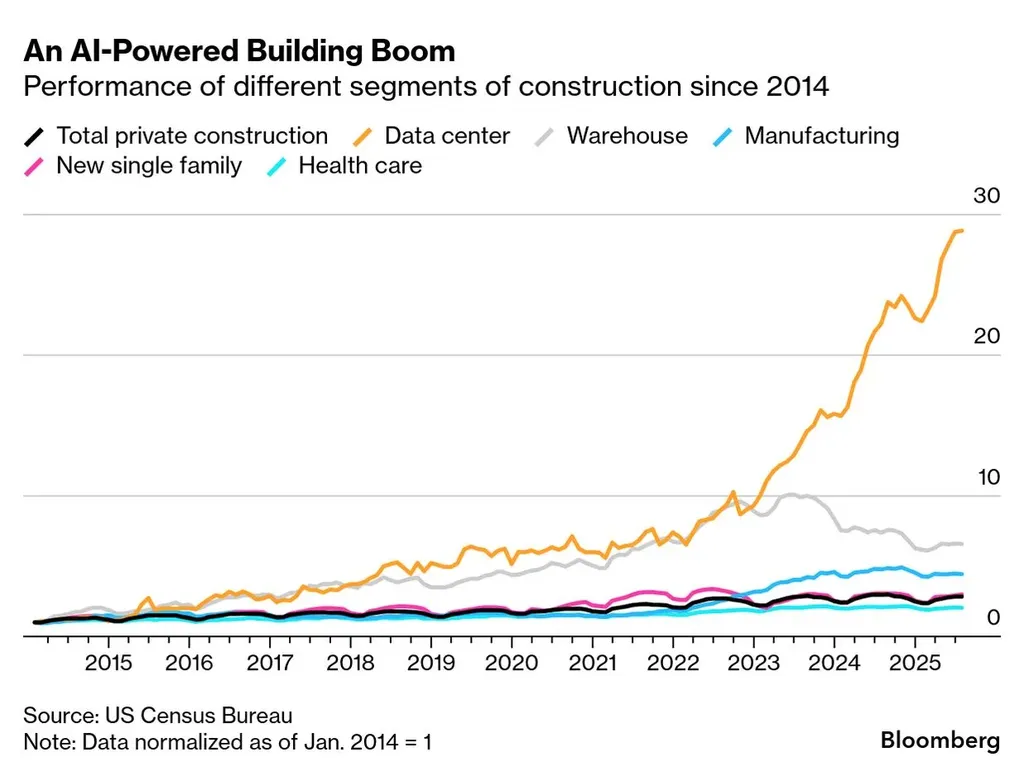In the ever-evolving landscape of the U.S. economy, a stark divide has emerged, painting a picture of a nation split between the booming artificial intelligence (A.I.) sector and the struggling traditional industries. This dichotomy is reshaping regional economies, labor markets, and even the very fabric of the construction industry, leaving professionals to grapple with both opportunities and challenges.
The A.I. Gold Rush
The A.I. sector is experiencing a gold rush of unprecedented proportions. Investments in computer equipment and software have surged, accounting for over 90% of the growth in gross domestic product (GDP) in the first half of 2025. This surge is driven by the rapid expansion of data centers, which are sprouting up like theme parks across the country. These facilities, essential for powering A.I. models, are fueling demand for everything from cooling systems to power-generation equipment.
The ripple effects of this boom are evident in sectors as diverse as manufacturing and construction. Companies like Caterpillar, Johnson Controls, and Eaton Corp. are reaping the benefits, with Eaton alone investing over $1 billion to expand its manufacturing capacity. The American Cement Association estimates that A.I. data centers will use approximately one million metric tons of cement over the next three years, underscoring the sector’s impact on construction materials.
However, this growth is not evenly distributed. While A.I. developers and chipmakers rake in hundreds of billions of dollars, the rest of the economy is feeling the pinch. Unemployment has risen, hiring has slowed, and industries like manufacturing and home building are cutting jobs. The public sector, weighed down by budget cuts and federal layoffs, is also struggling.
The Construction Paradox
The construction industry is a microcosm of this two-track economy. Nonresidential construction spending has fallen, continuing a downward trend, and home building is well below its pandemic-era peak. Yet, data center construction is swelling, providing a lifeline to an otherwise struggling sector.
In Nevada, a summer of weak international tourism has stunted hiring and weakened the local economy. But the data-center construction boom tied to the fast-growing A.I. industry has helped to soften the blow. Similarly, in the Washington D.C. area, federal job cuts and the longest government shutdown on record have threatened to push the regional economy into a recession. But there, too, A.I.-related investments are helping to offset the damage. And in North Dakota, low oil prices have idled drilling rigs and dented state revenues, but A.I. data centers are helping to fill the gap.
The construction industry’s reliance on A.I. as a source of growth raises a critical question: What happens if the gold rush stops? The threat is most obvious in the stock market, where a handful of A.I.-focused companies have driven record highs. A bursting of the bubble could have real-world implications, potentially leading to job losses in the service sector and a downward spiral in the labor market.
The Human Factor
The two-track economy is not just an economic phenomenon; it’s a human one. The benefits of the A.I. boom are concentrated in large “superstar” cities, while the rest of the country grapples with job losses and economic uncertainty. The construction industry, in particular, is feeling the strain. Contractors like Chuck Goodrich, CEO of Gaylor Electric, are seeing a surge in business tied to data center construction. Yet, the abundance isn’t reaching everyone or everywhere.
The companies developing leading A.I. models, like OpenAI and Google, are mostly headquartered in the San Francisco area, and their highest-paid employees are concentrated in these large cities. Meanwhile, investments in A.I. infrastructure are spread out, but the benefits are much less certain. Some of the largest data centers are being built in rural areas, where land is cheap, and jobs have been disappearing for decades.
The construction industry stands at a crossroads. While the A.I. boom presents opportunities for growth and innovation, it also underscores the need for a more inclusive and resilient economy. As Mark Muro, an economist at the Brookings Institution, puts it, “This A.I. gold rush is generating all the excitement and papering over a drift in the rest of the economy.” The challenge for the construction industry—and the broader economy—is to ensure that the benefits of this technological revolution are shared widely and equitably.

